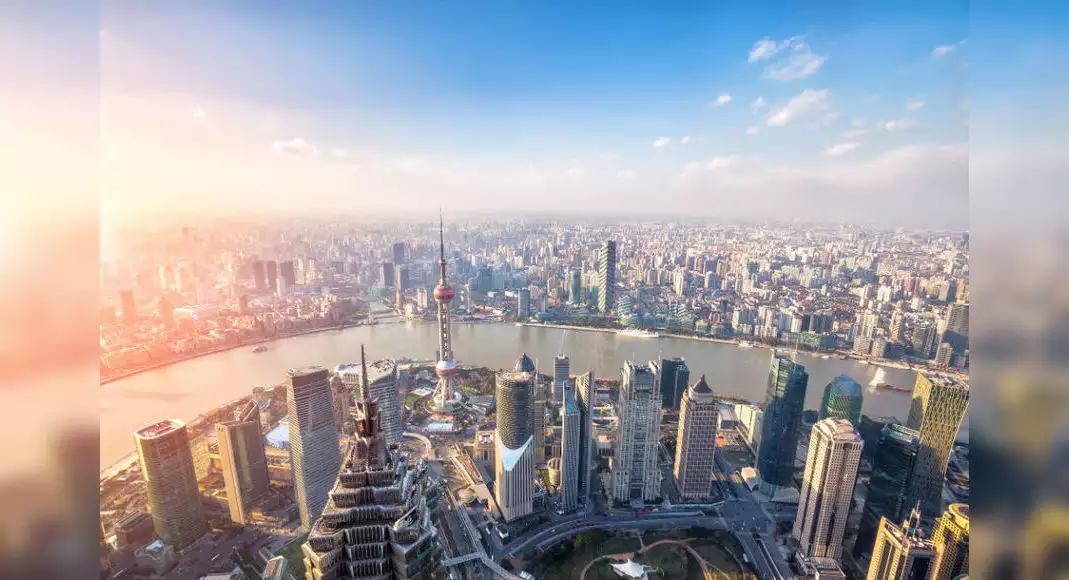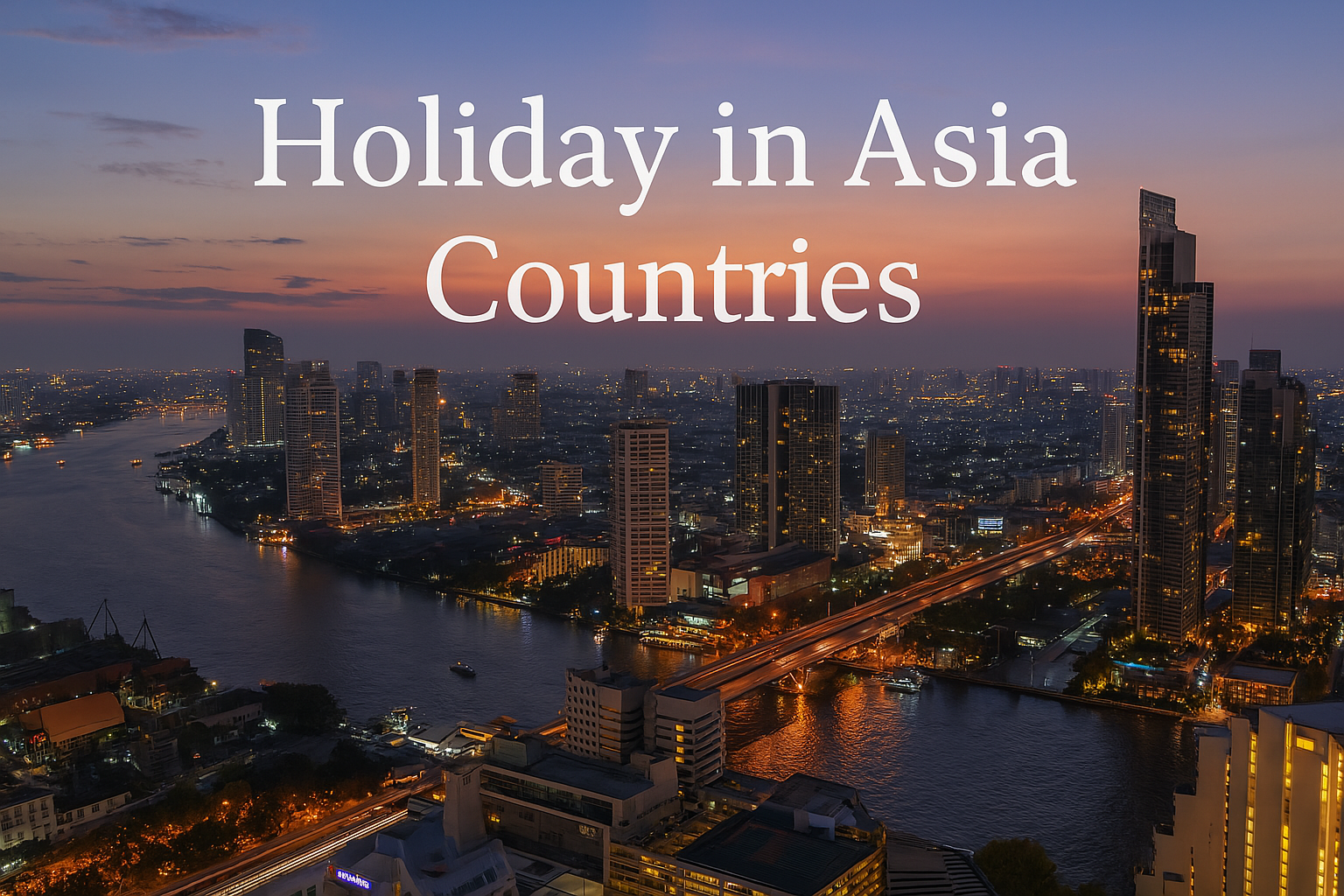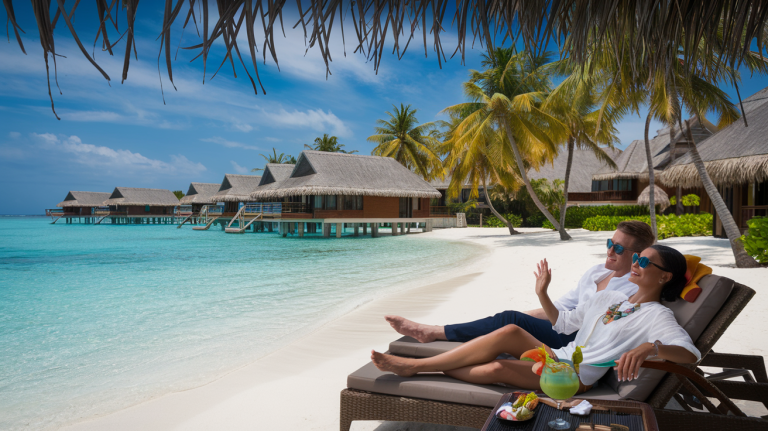
When I first set foot in Asia five years ago, I was completely unprepared for how it would transform my perspective on travel. From the moment the humid air of Bangkok enveloped me to watching the sunrise over Angkor Wat’s ancient stones, I realized Asia isn’t just a destination—it’s an experience that engages all your senses.
Asia‘s diversity is unmatched—where else can you find futuristic cities like Tokyo, pristine beaches in Bali, ancient temples in Cambodia, and mouthwatering street food at every corner? Whether you’re planning your first Asian adventure or returning to explore new territories, this guide will help you navigate the continent’s most breathtaking destinations.
Join me as we explore the best countries, must-visit locations, and essential tips for making your holiday in Asia unforgettable. From budget-friendly strategies to cultural insights, I’ve gathered everything you need to know before embarking on your journey across this magnificent continent.
Best Countries to Visit in Asia
Asia’s vast expanse offers seemingly endless travel possibilities. Here are the countries that consistently rank as traveler favorites, each with its own unique charm:
Thailand: The Land of Smiles
Thailand remains the perfect entry point for Asia first-timers. The country strikes an ideal balance between accessibility and adventure, offering pristine beaches in the south, lush mountains in the north, and vibrant city experiences in Bangkok.
Why visit: Friendly locals, affordable luxury, incredible food, and diverse landscapes make Thailand a complete package for any traveler.
Don’t miss: The Grand Palace in Bangkok, island hopping in Krabi, exploring Chiang Mai’s temples, and participating in the famous Full Moon Party if you’re feeling adventurous.

Vietnam: A Country of Contrasts
Vietnam captivates visitors with its dramatic landscapes, complex history, and amazing cuisine. The country stretches like a dragon along the eastern coast of the Indochina Peninsula, offering everything from mountain treks to beach relaxation.
Why visit: Vietnam delivers incredible value for money, remarkably friendly people, and some of the best food you’ll ever taste.
Don’t miss: Cruising through limestone karsts in Ha Long Bay, wandering the lantern-lit streets of Hoi An’s Ancient Town, and exploring the Cu Chi Tunnels for a sobering look at wartime history.
Japan: Tradition Meets Innovation
Japan fascinates with its seamless blend of ancient traditions and cutting-edge technology. From serene temples to robot restaurants, Japan offers experiences you’ll find nowhere else.
Why visit: Exceptional safety, cleanliness, efficient transportation, and unique cultural experiences make Japan worth the higher price tag compared to other Asian destinations.
Don’t miss: Cherry blossom season if you visit in spring, exploring Tokyo’s diverse neighborhoods, visiting Kyoto’s temples, and experiencing the controlled chaos of Shibuya Crossing.
Indonesia: Island Paradise
With over 17,000 islands, Indonesia offers incredible diversity—from the spiritual hub of Bali to the wild jungles of Borneo and the traditional villages of Flores.
Why visit: Stunning natural beauty, world-class surfing, diving, and snorkeling, plus a rich cultural heritage.
Don’t miss: Bali’s sacred temples and beaches, the dragons of Komodo National Park, and sunrise at Borobudur Temple.
China: Ancient Wonders and Modern Marvels
China’s vast territory encompasses everything from the futuristic skylines of Shanghai to the ancient wonders of the Great Wall and the ethereal landscapes of Zhangjiajie that inspired the movie Avatar.
Why visit: Unparalleled historical sites, diverse regional cuisines, and a chance to witness a country rapidly transforming while maintaining its ancient roots.
Don’t miss: Walking the Great Wall, exploring the Forbidden City in Beijing, and cruising down the Li River through karst mountains that appear in traditional Chinese paintings.
When to Visit Asia: Timing Your Trip Right
Asia’s weather patterns vary dramatically by region, making the timing of your trip crucial. Here’s my breakdown of the best times to visit different parts of Asia:
Southeast Asia (Thailand, Vietnam, Cambodia, Indonesia)
Best time to visit: November to February Why: This is the dry season with comfortable temperatures in most areas. Avoid: March to May (extremely hot) and June to October (monsoon season in many areas)
East Asia (Japan, China, South Korea)
Best time to visit: Spring (March to May) or autumn (September to November) Why: Mild temperatures and stunning seasonal changes (cherry blossoms in spring, fall foliage in autumn) Avoid: Summer can be extremely hot and humid, while winter can be bitterly cold, especially in northern regions
South Asia (India, Nepal, Sri Lanka)
Best time to visit: October to March Why: Cooler, drier conditions throughout most of the region Avoid: April to June (extreme heat) and July to September (monsoon season)
Central Asia (Kazakhstan, Uzbekistan)
Best time to visit: April to June and September to October Why: Moderate temperatures ideal for sightseeing Avoid: July and August (very hot) and November to March (cold, sometimes snowy)
Top 10 Must-Visit Destinations in Asia
Based on my travels and traveler feedback, these are the locations that consistently deliver unforgettable experiences:
1. Bangkok, Thailand
The vibrant capital of Thailand serves as the perfect introduction to Southeast Asia. The city is a fascinating mix of chaos and order, with gleaming temples standing alongside bustling markets and skyscrapers.
Why it’s special: Bangkok offers an accessible taste of Asian culture with excellent infrastructure for tourists. The contrast between spiritual temples and hedonistic nightlife creates a fascinating dynamic.
Best experiences: Exploring the Grand Palace and Wat Pho, taking a long-tail boat through the canals, sampling street food at Chatuchak Weekend Market, and enjoying sunset drinks at a rooftop bar overlooking the city.
2. Tokyo, Japan
Tokyo epitomizes the perfect blend of tradition and innovation that makes Japan so fascinating. From tranquil gardens to robotic restaurants, Tokyo delivers sensory overload in the best possible way.
Why it’s special: Tokyo offers unparalleled safety, cleanliness, and efficiency while still providing cultural experiences that feel completely foreign to Western visitors.
Best experiences: Witnessing the organized chaos of Shibuya Crossing, exploring the pop culture paradise of Akihabara, finding peace in Shinjuku Gyoen National Garden, and dining at an izakaya among locals.
3. Bali, Indonesia
This Indonesian island has captured travelers’ imaginations with its perfect blend of beach relaxation, cultural experiences, and natural beauty.
Why it’s special: Bali offers spiritual experiences alongside beach parties, luxury villas next to budget hostels, and traditional villages just a short ride from tourist hotspots.
Best experiences: Watching sunrise from Mount Batur, exploring the terraced rice fields of Tegallalang, temple-hopping to Uluwatu and Tanah Lot, and unwinding on the beaches of Nusa Dua or Seminyak.
4. Hoi An, Vietnam
This exceptionally preserved ancient trading port charmed me instantly with its colorful lanterns, talented tailors, and relaxed atmosphere.
Why it’s special: Hoi An offers a perfectly preserved glimpse into the past while providing modern comforts and exceptional cuisine.
Best experiences: Wandering the lantern-lit Ancient Town at night, ordering custom-made clothing from local tailors, taking a cooking class, and cycling through nearby rice paddies.
5. Angkor Wat, Cambodia
This architectural marvel represents the pinnacle of Khmer civilization and remains one of humanity’s most impressive achievements.
Why it’s special: The sheer scale and artistic detail of Angkor’s temples are humbling, offering spiritual and historical insights alongside incredible photo opportunities.
Best experiences: Watching sunrise over the main temple complex, exploring the tree-entangled ruins of Ta Prohm, and discovering lesser-known temples away from the crowds.
6. Kyoto, Japan
While Tokyo represents modern Japan, Kyoto embodies its traditional heart with over 1,600 Buddhist temples, 400 Shinto shrines, and 17 UNESCO World Heritage Sites.
Why it’s special: Kyoto offers a deeper understanding of Japanese aesthetics, philosophy, and traditions in a more manageable setting than Tokyo.
Best experiences: Walking the Philosopher’s Path, witnessing the golden splendor of Kinkaku-ji (Golden Pavilion), spotting geisha in Gion district, and experiencing a traditional tea ceremony.
7. Hong Kong
This dynamic city blends Chinese and British influences in a dramatic setting of skyscrapers nestled between mountains and harbor.
Why it’s special: Hong Kong offers incredible food, shopping, and hiking opportunities alongside one of the world’s most impressive skylines.
Best experiences: Taking the tram to Victoria Peak for harbor views, riding the Star Ferry between Kowloon and Hong Kong Island, sampling dim sum, and exploring the markets of Mong Kok.
8. Chiang Mai, Thailand
Northern Thailand’s cultural capital offers a more relaxed alternative to Bangkok with incredible temples, cuisine, and access to mountain adventures.
Why it’s special: Chiang Mai provides cultural immersion in a manageable, affordable package with some of Thailand’s best food and handicrafts.
Best experiences: Chatting with monks during “monk chats” at temples, taking a Thai cooking class, exploring the Sunday Night Walking Street, and visiting ethical elephant sanctuaries.
9. Seoul, South Korea
South Korea’s capital showcases the country’s remarkable journey from war-torn nation to technological powerhouse, all while preserving its cultural heritage.
Why it’s special: Seoul offers fascinating contrasts between ancient palaces and futuristic architecture, traditional markets and high-end shopping districts.
Best experiences: Exploring Gyeongbokgung Palace in traditional hanbok dress, shopping in Myeongdong, hiking urban mountain trails for city views, and experiencing Korean barbecue and karaoke culture.
10. Ha Long Bay, Vietnam
This UNESCO World Heritage Site features thousands of limestone karsts rising dramatically from emerald waters, creating one of Asia’s most recognizable landscapes.
Why it’s special: The otherworldly scenery of Ha Long Bay has inspired artists and poets for centuries, offering a serene contrast to Vietnam’s bustling cities.
Best experiences: Taking an overnight cruise, kayaking through hidden lagoons, exploring floating fishing villages, and watching sunset transform the karst formations.
Budget-Friendly Travel Tips for Asia
One of Asia’s greatest appeals is the ability to experience incredible destinations without breaking the bank. Here are my top tips for traveling Asia on a budget:
Accommodation Strategies
- Consider hostels: Even if dormitories aren’t your style, many Asian hostels offer affordable private rooms with shared facilities.
- Look beyond tourist areas: Staying just a few streets away from major attractions can significantly reduce costs.
- Try homestays: Platforms like Airbnb often offer rooms in local homes that cost less than hotels while providing cultural insights.
- Negotiate long-term stays: If staying somewhere for a week or more, ask for discounted rates directly with the property.
Food and Dining
- Eat street food: Some of Asia’s best cuisine comes from street vendors and costs a fraction of restaurant prices.
- Look for busy local spots: Restaurants filled with locals (not tourists) usually offer the best value and quality.
- Try the set lunch: Many restaurants offer set lunch menus that cost significantly less than dinner service.
- Visit markets: Local markets offer fresh, inexpensive food and a glimpse into daily life.
Transportation Tips
- Use public transport: Metro systems in cities like Tokyo, Singapore, and Bangkok are clean, efficient, and affordable.
- Consider overnight trains: Save on accommodation while covering long distances.
- Book flights in advance: Budget airlines like AirAsia and Scoot offer incredible deals when booked early.
- Rent motorbikes wisely: In countries like Vietnam and Thailand, motorbike rental can be affordable, but ensure you have proper insurance and licensing.
Safety Tips for Traveling in Asia
While Asia is generally safe for travelers, taking precautions will help ensure a smooth journey:
- Research local scams: Each destination has common scams targeting tourists. Knowing these beforehand helps you avoid them.
- Keep valuables secure: Use hotel safes, money belts, and anti-theft bags, especially in crowded areas.
- Respect local customs: Learning basic etiquette for each country prevents unintentional offense.
- Dress appropriately: Particularly at religious sites, covering shoulders and knees shows respect and avoids unwanted attention.
- Stay hydrated and sun-protected: Asian heat can be intense, especially if you’re not accustomed to tropical climates.
- Get travel insurance: Medical emergencies abroad can be extremely costly without proper coverage.
Navigating Cultural Differences
Asia’s rich cultural tapestry is part of what makes traveling here so rewarding. Here are some tips for respectful cultural navigation:
Religious Etiquette
- Temple visits: Remove shoes before entering temples, avoid pointing feet at Buddha images, and dress modestly.
- Sacred sites: Follow local customs about photography, speaking volumes, and restricted areas.
- Religious festivals: These can be incredible experiences but research appropriate behavior beforehand.
Communication
- Learn basic phrases: Even simple greetings in the local language are greatly appreciated.
- Non-verbal communication: Be aware that gestures considered innocuous in Western countries may be offensive elsewhere.
- Saving face: Many Asian cultures prioritize harmony and avoiding embarrassment, so public criticism can be particularly hurtful.
Preparing for Your Trip
Proper preparation ensures your Asian adventure starts smoothly:
Health Preparations
- Vaccinations: Consult a travel clinic at least 6-8 weeks before departure.
- Medication: Bring prescription medications in original packaging with a doctor’s note.
- First aid kit: Include remedies for common traveler ailments like stomach problems and motion sickness.
Visa Requirements
- Research in advance: Visa requirements vary widely across Asian countries and change frequently.
- Consider multi-entry visas: If you plan to cross borders multiple times.
- Visa on arrival: Where available, check if online pre-registration is required.
Packing Essentials
- Adaptable clothing: Layers work well for varying climates and cultural contexts.
- Modest options: Pack clothes that cover shoulders and knees for temple visits.
- Quality footwear: You’ll likely walk more than expected, often on uneven surfaces.
- Universal adapter: Electric outlets vary across Asian countries.
Experiencing Asia’s Incredible Food Scene
No discussion of Asian travel would be complete without celebrating its incredible cuisines:
Must-Try Dishes by Country
- Thailand: Tom Yum Goong (spicy shrimp soup), Pad Thai, Massaman Curry
- Japan: Sushi, Ramen, Okonomiyaki (savory pancake)
- Vietnam: Pho (noodle soup), Banh Mi (sandwich), Fresh Spring Rolls
- China: Peking Duck, Dim Sum, Hand-Pulled Noodles
- India: Butter Chicken, Masala Dosa, Chaat (savory snacks)
Food Safety Tips
- Street food wisdom: Choose stalls with high turnover and where locals eat.
- Hot and fresh: Food cooked hot and served immediately is generally safer.
- Fruit strategies: Eat fruits you can peel yourself and avoid pre-cut options.
- Water awareness: Stick to bottled water in most countries and avoid ice in places with questionable water quality.
Conclusion: Why Asia Should Be Your Next Holiday Destination
After exploring dozens of countries across multiple continents, I keep returning to Asia. The continent’s unparalleled diversity means you can experience spiritual awakening at ancient temples, adventure through pristine natural landscapes, indulge in world-class cuisine, and witness cutting-edge urban innovation—all within a single trip.
Whether you’re drawn to Thailand’s perfect beaches, Japan’s fascinating blend of tradition and technology, or Vietnam’s dramatic landscapes and complex history, Asia rewards travelers with experiences that challenge perspectives and create lifelong memories.
The best part? With proper planning, Asia can offer these transformative experiences at a fraction of the cost of holidays in Europe or North America. From budget backpacking to luxury resorts, Asia accommodates every travel style and budget.
As you plan your journey through this remarkable continent, remember that flexibility and openness to unexpected experiences often lead to the most memorable adventures. Pack your curiosity alongside your camera, and prepare for a holiday that might just change how you see the world.
What Asian destination is calling your name? Have questions about planning your perfect Asian getaway? Drop a comment below—I’d love to help you start your own Asian adventure story!



